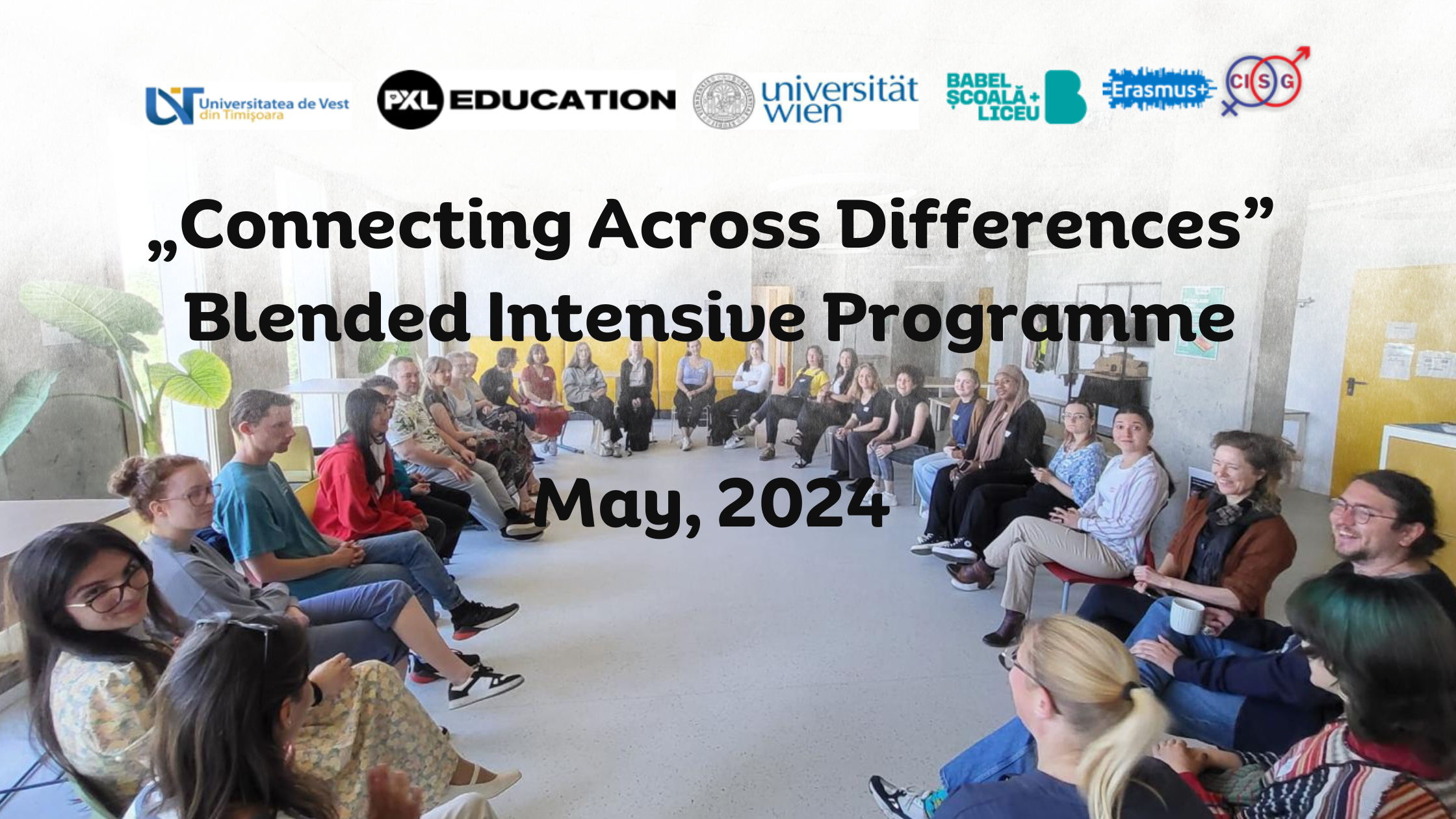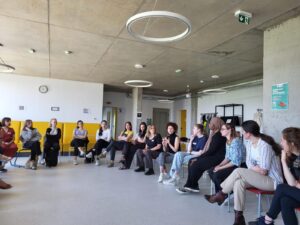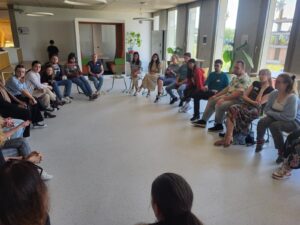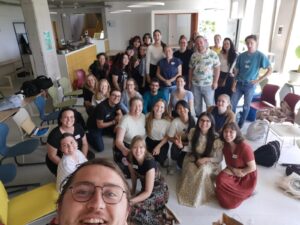Cum văd studenții din Belgia, Austria și România școala noastră
În luna mai 2024, școala noastră a avut plăcerea de a găzdui o vizită deosebită și valoroasă din partea unui grup de studenți din Belgia, Austria și România. Această oportunitate a fost posibilă prin programul „Connecting Across Differences” Blended Intensive Programme (BIP), organizat de Universitatea de Vest Timișoara, Universitatea din Viena, PXL Education Belgia, Erasmus+ și CISG.
Andrei Nicolescu, psiholog consilier la Babel, a condus grupul de studenți, prezentând principiile fundamentale ale școlii noastre și facilitând comunicarea cu elevii și profesorii noștri. Vizita a fost o ocazie minunată de schimb de idei și de îmbogățire a experienței educaționale pentru toți cei implicați.
Care este obiectivul acestui program?
Cu deviza „Nu lăsăm pe nimeni în urmă”, promisiunea centrală a Agendei 2030 și a Obiectivelor de Dezvoltare Durabilă, este esențial ca viitorii profesori la nivel global să fie conștienți și implicați în acest efort. Programul urmărește să crească conștientizarea rolului pe care limbajul și conceptele îl joacă în promovarea diviziunii și polarizării în clasă și în contextul social extins. Dat fiind că profesorii sunt actori cheie în promovarea diversității în sălile de clasă, acest BIP își propune să îmbunătățească practicile de răspuns la diversitate. Astfel, cursul se concentrează pe reflecția critică asupra a ceea ce modelează modurile noastre de gândire și pe reîncadrarea prejudecăților (implicite) care ar putea afecta negativ viitorii elevi. Compararea obiceiurilor și sistemelor din cele trei țări participante sprijină o percepție mai conștientă a propriului sistem școlar și a obiceiurilor pedagogice.
In agenda programului, studenții belgieni și austrieci au avut o zi dedicată interacțiunii cu profesorii și tot ceea ce înseamnă Babel Școală + Liceu, mai exact, activităților de predare și observare concluzionată cu o sesiune de reflecție.
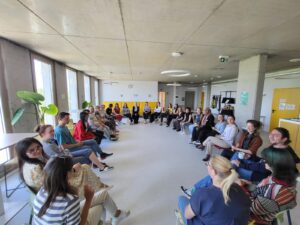
Ce feedback am primit de la studenți în urma interacțiunii cu Babel Școală + Liceu?
Pentru o mai bună înțelegere a mesajului transmis de studenți, transcriem aici mesajele scrise de ei în limba engleză.
I thought the way the school works, is very inspiring. You can feel the passion from the teachers, and the pupils feel seen and heard. It feels like a very peaceful environment where the students can thrive to be the best version of themselves.
– Joke Roosenbroeck (Belgian student)I thought there was a nice atmosphere in the school. The concept is unique and something that absolutely supports inclusion. It was a great experience teaching the children, most of them were very enthusiastic and cooperated very well. This school is a good example of how working together as one team can achieve a lot.
Thank you Baboa coala for these new experiences and insights.
– Rachel (Belgian student)Teaching at Babel was one of the activities I was most looking forward to. Upon arrival, I was pleasantly surprised. I had already heard that many Romanian schools had quite neglected infrastructure, and that the teaching itself was apparently more outdated. Babel Scoala, on the other hand, was the complete opposite of what I had expected. It had a very modern infrastructure and a friendly team of teachers. I was very surprised to see a poster on non-violent communication in the teachers’ room. It was nice to hear that teachers here were actively engaged with it and actually implemented it in their classroom practice. The classrooms were nicely arranged. The traditional setup of the rooms was completely broken by desks that were easily movable. This also made it easier to try out group work or other work forms in the classrooms. Additionally, I found it unusual that music was played during breaks. I had never encountered this in the schools where I had previously done internships. It certainly added an extra touch to a pleasant atmosphere.
– Angie (Belgian student)During my time at the Babel School in Timisoara, I was pleasantly surprised by several aspects that contributed to a highly positive learning environment. The school’s infrastructure is impressive, with modular desks that can be easily rearranged to suit different activities. The plants and the vibrant colors throughout the school create a welcoming and stimulating atmosphere. I found the music during the breaks to be a refreshing element. It immediately creates a relaxed and homely atmosphere.
One of the most remarkable observations was how attentive the teachers were to each pupil’s needs. The students were encouraged to be themselves, which is essential for optimal learning. I noticed various strategies in place to accommodate individual needs: some students used toy cars on their desks to manage their restlessness, another had a taped-off area to define their personal space, and one student would occasionally take a brief moment to isolate themselves. These practices demonstrated the school’s commitment to meeting each child’s unique requirements. The teachers truly see each student and their unique needs. Our work centered on emotions and needs, and it was evident that these students were adept at expressing their feelings. This proficiency indicated that they had practiced articulating their emotions extensively. In the final part of the lesson, we focused on needs. The students participated in an exercise where they filled and illustrated glasses to represent how well their needs were being met. It was heartwarming to see that when discussing the need for love, some students’ glasses were overflowing.
My heart overflowed as well.
Additionally, the teacher had Tibetan bells next to the board, which proved to be an effective way to get the class’s attention without raising my voice. Inspired by this, I plan to incorporate these bells into my own classroom in the future. Finally, I also saw ample room for creativity. Making history tangible by having students process it through projects and making it visible aligns with my vision of education. I saw beautiful examples, such as a project on the Hiroshima atomic bomb, a work on the Great Wall of China, and toy soldiers reenacting the Battle of Normandy. By allowing students to create their own products and thereby solidify their learning material, this method of knowledge transfer is highly effective. And even more importantly, creativity is encouraged. Creating something yourself is the most beautiful thing there is.Saskia Sterck (Belgian teacher)
